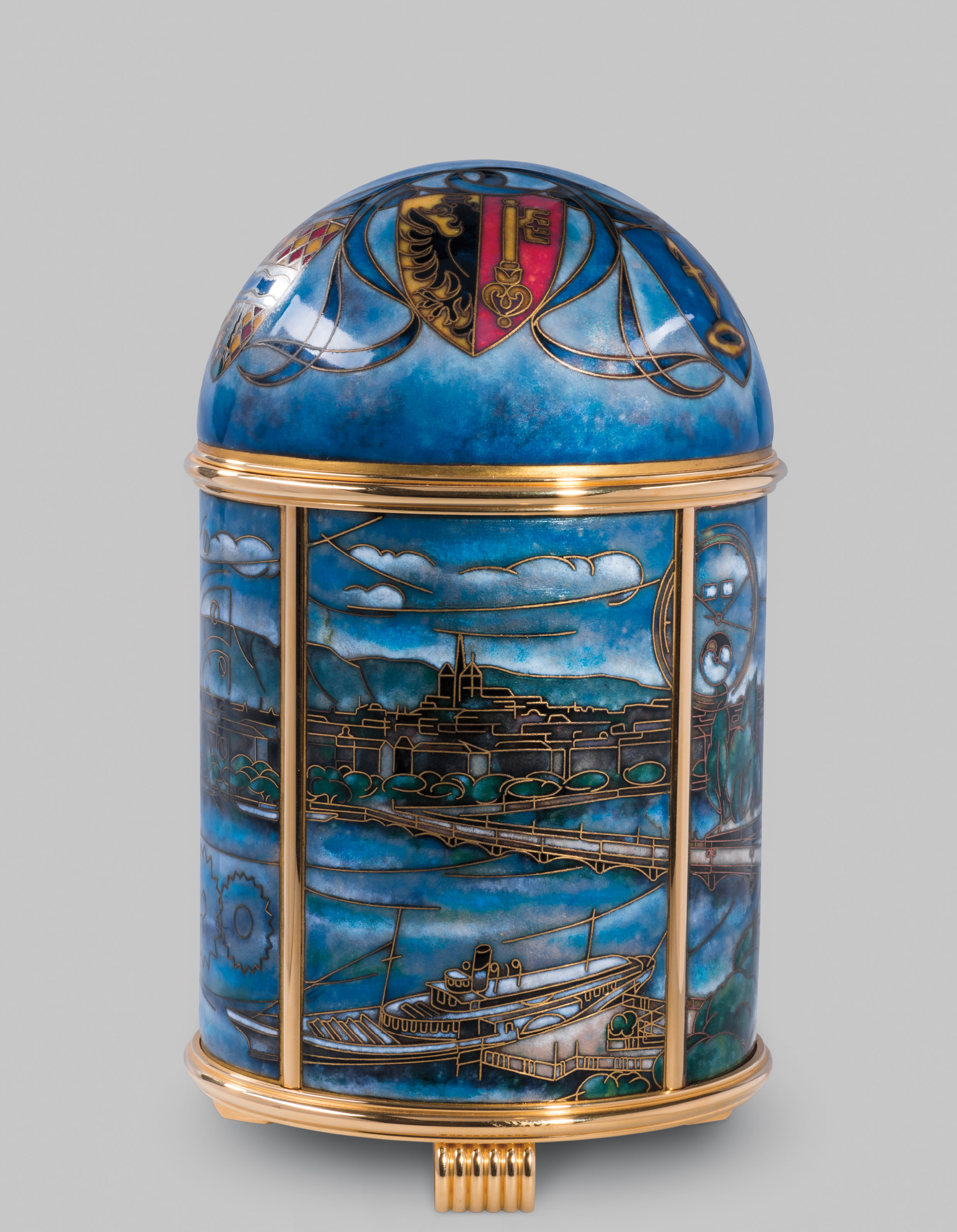









74
Patek Philippe
Ref. 743E
"La Rade de Genève"
An extremely fine and unique gilt brass solar power mechanical dome table clock with cloisonné enamel depicting the Geneva harbour
- Estimate
- CHF120,000 - 250,000€111,000 - 232,000$119,000 - 248,000
CHF490,000
Lot Details
- Manufacturer
- Patek Philippe
- Year
- 1959
- Reference No
- 743E
- Movement No
- 872'783
- Model Name
- "La Rade de Genève"
- Material
- Gilt brass and enamel
- Calibre
- Solar powered manual, cal. 17-250, 29 jewels
- Dimensions
- 210 mm. high
- Signed
- Dial and movement signed, enamel signed MD for Michel Deville
- Accessories
- Accompanied by Patek Philippe Extract from the Archives confirming date of manufacture of the present clock in 1959 and its subsequent sale on August 10th, 1959
Specialist
Full-Cataloguing
Catalogue Essay
Patek Philippe cloisonné enamel dome table clocks have tremendously increased in value and collectability in the last few years. A potent mix of cutting edge technology and traditional handcraftsmanship, each piece is unique with varying themes. Only a very small select number of artists are qualified to work on such objects that have curves to the panels where the enamel lies.
Housing the Patek Philippe manual caliber 17-250, a small rotatable solar panel on the top of the dome supplies energy to a storage device within, which in turn transmits energy to power the mechanical movement.
In 1948 Patek Philippe opened its Electronic Division with the goal of exploring photoelectric, electronic, and nuclear timekeeping. The department is responsible for the creation of the groundbreaking solar clock, the first of its kind. A Swiss patent was awarded to Patek Philippe for clocks fitted with photo-electric cells. Patek Philippe's idea for a light-powered horological mechanism was to introduce additional electronic storage – an accumulator that provides the energy to wind the spring. The photoelectric cells can either store their energy electronically in the accumulator, or mechanically by winding the spring. When the mechanism is fully wound, the cells switch over to charge the accumulator.
The oldest solar powered dome clock with enamel panels known, dates from 1957 preceding the present lot by only two years.
The enamel of the present dome clock was created by Michel Deville in 1959. Michel Deville was responsible for some of the most vibrant and attractive enamel work found on different Patek Philippe dome clocks. The theme of the present lot represents the Geneva harbor as seen from the Quai du Mont-Blanc. The vivid, blues, greens and purples depict the serene atmosphere of the Old Town with its majestic Cathedral and even the Mont-Blanc Bridge leading to Patek Philippe’s historical Salon. Overlaid on this landscape the enamel artist has placed watchmaking tools, gears and plates which resemble the rectangular caliber 9""-90 and even one can make out the dial of Patek Philippe’s reference 2497 perpetual calendar.
A certain mystery however surrounds the coat of arms found on the dome, taking central position is the coat of arms of the Canton of Geneva which seems logical considering the theme of the enamel work. However, on the right is placed the coat of arms of the city of Le Locle a Swiss watchmaking power center, on the left of the Geneva "blason" is a coat of arms like the such we have never seen. Was this clock made for a Swiss exhibition honoring Swiss watchmaking? Was it a special order explaining the different coat of arms? In any event, many of these dome clocks featured generic themes such as wildlife, flowers or architecture, examples such as the present with a specific theme are the most covetable and to the best of our knowledge the present clock is the only one merging city and horological themes.
This clock first appeared to the market in 2007 and has since been part of a very important private collection. The cloisonné enamel is free of any restoration and shows very vibrant colours. In exceptional condition throughout, this present lot is a terrific example of Patek Philippe’s forward thinking designs and is a superb addition to any collection.
Housing the Patek Philippe manual caliber 17-250, a small rotatable solar panel on the top of the dome supplies energy to a storage device within, which in turn transmits energy to power the mechanical movement.
In 1948 Patek Philippe opened its Electronic Division with the goal of exploring photoelectric, electronic, and nuclear timekeeping. The department is responsible for the creation of the groundbreaking solar clock, the first of its kind. A Swiss patent was awarded to Patek Philippe for clocks fitted with photo-electric cells. Patek Philippe's idea for a light-powered horological mechanism was to introduce additional electronic storage – an accumulator that provides the energy to wind the spring. The photoelectric cells can either store their energy electronically in the accumulator, or mechanically by winding the spring. When the mechanism is fully wound, the cells switch over to charge the accumulator.
The oldest solar powered dome clock with enamel panels known, dates from 1957 preceding the present lot by only two years.
The enamel of the present dome clock was created by Michel Deville in 1959. Michel Deville was responsible for some of the most vibrant and attractive enamel work found on different Patek Philippe dome clocks. The theme of the present lot represents the Geneva harbor as seen from the Quai du Mont-Blanc. The vivid, blues, greens and purples depict the serene atmosphere of the Old Town with its majestic Cathedral and even the Mont-Blanc Bridge leading to Patek Philippe’s historical Salon. Overlaid on this landscape the enamel artist has placed watchmaking tools, gears and plates which resemble the rectangular caliber 9""-90 and even one can make out the dial of Patek Philippe’s reference 2497 perpetual calendar.
A certain mystery however surrounds the coat of arms found on the dome, taking central position is the coat of arms of the Canton of Geneva which seems logical considering the theme of the enamel work. However, on the right is placed the coat of arms of the city of Le Locle a Swiss watchmaking power center, on the left of the Geneva "blason" is a coat of arms like the such we have never seen. Was this clock made for a Swiss exhibition honoring Swiss watchmaking? Was it a special order explaining the different coat of arms? In any event, many of these dome clocks featured generic themes such as wildlife, flowers or architecture, examples such as the present with a specific theme are the most covetable and to the best of our knowledge the present clock is the only one merging city and horological themes.
This clock first appeared to the market in 2007 and has since been part of a very important private collection. The cloisonné enamel is free of any restoration and shows very vibrant colours. In exceptional condition throughout, this present lot is a terrific example of Patek Philippe’s forward thinking designs and is a superb addition to any collection.
Literature
Patek Philippe
Swiss | 1839Since its founding in 1839, this famous Geneva-based firm has been surprising its clientele with superbly crafted timepieces fitted with watchmaking's most prestigious complications. Traditional and conservative designs are found across Patek Philippe's watches made throughout their history — the utmost in understated elegance.Well-known for the Graves Supercomplication — a highly complicated pocket watch that was the world’s most complicated watch for 50 years — this family-owned brand has earned a reputation of excellence around the world. Patek's complicated vintage watches hold the highest number of world records for results achieved at auction compared with any other brand. For collectors, key models include the reference 1518, the world's first serially produced perpetual calendar chronograph, and its successor, the reference 2499. Other famous models include perpetual calendars such as the ref. 1526, ref. 3448 and 3450, chronographs such as the reference 130, 530 and 1463, as well as reference 1436 and 1563 split seconds chronographs. Patek is also well-known for their classically styled, time-only "Calatrava" dress watches, and the "Nautilus," an iconic luxury sports watch first introduced in 1976 as the reference 3700 that is still in production today.
Browse Maker